Effects of replacing Laminaria japonica with mixed seaweed meal on growth performance, digestive and metabolic enzyme activities, and immune function of the sea cucumber Apostichopus japonicus (Selenka)
IF 3.2
2区 农林科学
Q1 FISHERIES
引用次数: 0
Abstract
Laminaria japonica is a widely cultivated and economically significant seaweed, commonly used as a primary feed ingredient in sea cucumber aquaculture due to its cost-effectiveness and high nutritional value. However, declining production and rising costs have prompted the exploration of alternative feed sources to support sustainable aquaculture practices. This study assessed the feasibility of substituting L. japonica with a mixed seaweed meal to enhance feed sustainability while sustaining the health and growth performance of Apostichopus japonicus. The control diet (P0) contained 70 % L. japonica meal, whereas experimental diets replaced it with a mixed seaweed blend (2:1:1:1 ratio of Sargassum polycystum, degummed L. japonica, Ulva lactuca, and Enteromorpha prolifera) at substitution levels of 25 %, 50 %, 75 %, and 100 % (P25-P100). Over an 84-day feeding trial, specific growth rate and protein efficiency ratio decreased significantly at substitution levels exceeding 25 %, with parallel reductions observed in intestinal trypsin and lipase activities. Hexokinase and succinate dehydrogenase activities peaked at 25 % substitution, and malate and pyruvate dehydrogenase reached maximum levels at 50 %. Acid and alkaline phosphatase activities increased at 25 % and 50 % substitution levels, whereas superoxide dismutase activity decreased, accompanied by elevated malondialdehyde content. Additionally, catalase and lysozyme activities, along with their corresponding mRNA expression, decreased at higher substitution levels. Notably, NF-κB (p105) mRNA expression declined at 75 % and 100 % substitution, while Toll-like receptor mRNA showed slight upregulation. The integrated biomarker response model revealed that 25 % substitution level yielded the highest physiological adaptability, and substitution levels exceeding 50 % induced significant stress responses. Cubic regression analysis identified an optimal substitution level of 17.28 % for maximizing growth performance. These findings provide a valuable reference for incorporating mixed seaweed meal into sea cucumber diets effectively.
混合海藻粕替代海带对刺参生长性能、消化代谢酶活性及免疫功能的影响
海带是一种被广泛种植和具有重要经济意义的海藻,由于其成本效益和高营养价值,通常被用作海参养殖的主要饲料原料。然而,产量下降和成本上升促使人们探索替代饲料来源,以支持可持续水产养殖做法。本研究评价了用混合海藻粕替代日本刺参在维持刺参健康和生长性能的同时提高饲料可持续性的可行性。对照饲粮(P0)中粳稻粉的含量为70 %,而试验饲粮中采用海藻混合饲料(以2:1:1:1的比例替换多囊马尾藻、脱胶粳稻、乳藻和浒苔),替代水平分别为25 %、50 %、75 %和100 % (P25-P100)。在84 d的饲养试验中,当替代水平超过25 %时,特定生长率和蛋白质效率显著降低,肠道胰蛋白酶和脂肪酶活性也显著降低。己糖激酶和琥珀酸脱氢酶活性在置换率为25% %时达到峰值,苹果酸脱氢酶和丙酮酸脱氢酶在置换率为50% %时达到最大值。在25 %和50 %替代水平下,酸性和碱性磷酸酶活性升高,而超氧化物歧化酶活性降低,同时丙二醛含量升高。此外,在较高的取代水平下,过氧化氢酶和溶菌酶活性及其相应的mRNA表达量下降。值得注意的是,NF-κB (p105) mRNA的表达在75% %和100% %的替代下下降,而toll样受体mRNA的表达略有上调。综合生物标志物响应模型显示,25 %替代水平产生最高的生理适应性,超过50 %替代水平诱导显著的胁迫反应。三次回归分析确定了17.28 %的最佳替代水平,以最大限度地提高生长性能。研究结果为在海参饲粮中有效添加海藻粉提供了有价值的参考。
本文章由计算机程序翻译,如有差异,请以英文原文为准。
求助全文
约1分钟内获得全文
求助全文
来源期刊

Aquaculture Reports
Agricultural and Biological Sciences-Animal Science and Zoology
CiteScore
5.90
自引率
8.10%
发文量
469
审稿时长
77 days
期刊介绍:
Aquaculture Reports will publish original research papers and reviews documenting outstanding science with a regional context and focus, answering the need for high quality information on novel species, systems and regions in emerging areas of aquaculture research and development, such as integrated multi-trophic aquaculture, urban aquaculture, ornamental, unfed aquaculture, offshore aquaculture and others. Papers having industry research as priority and encompassing product development research or current industry practice are encouraged.
 求助内容:
求助内容: 应助结果提醒方式:
应助结果提醒方式:


